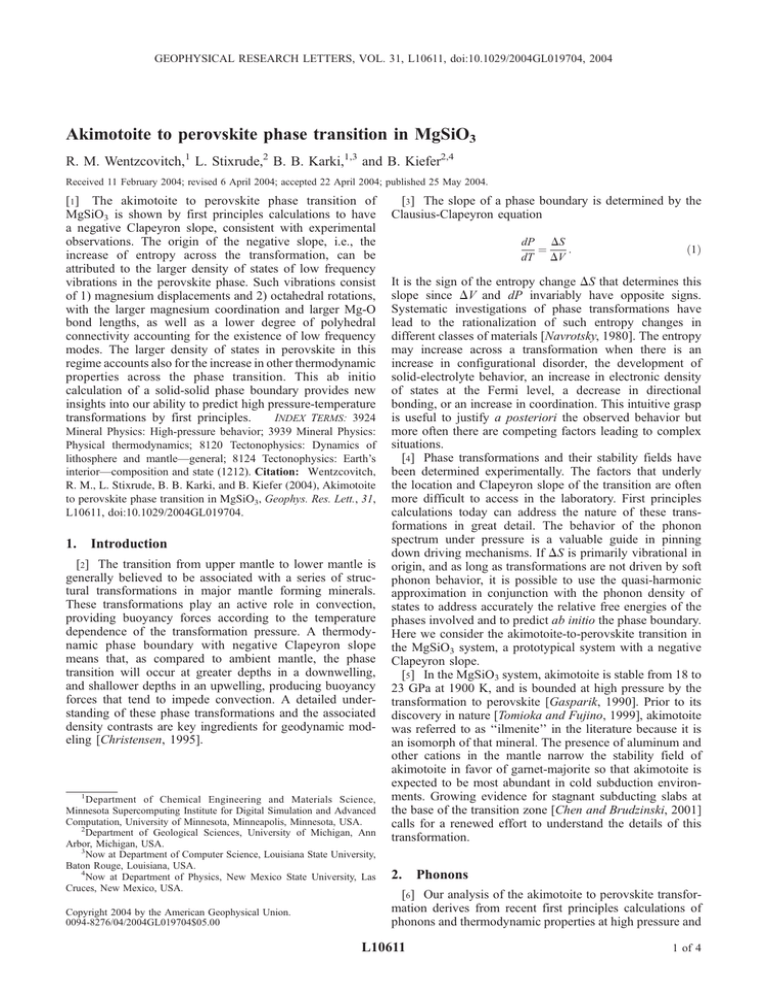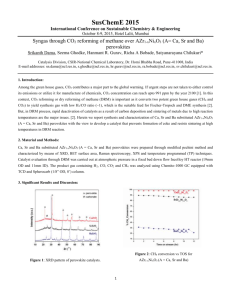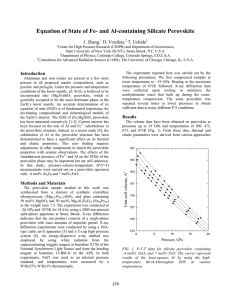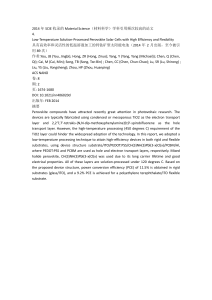Akimotoite to perovskite phase transition in MgSiO R. M. Wentzcovitch, L. Stixrude,
advertisement

GEOPHYSICAL RESEARCH LETTERS, VOL. 31, L10611, doi:10.1029/2004GL019704, 2004 Akimotoite to perovskite phase transition in MgSiO3 R. M. Wentzcovitch,1 L. Stixrude,2 B. B. Karki,1,3 and B. Kiefer2,4 Received 11 February 2004; revised 6 April 2004; accepted 22 April 2004; published 25 May 2004. [1] The akimotoite to perovskite phase transition of MgSiO3 is shown by first principles calculations to have a negative Clapeyron slope, consistent with experimental observations. The origin of the negative slope, i.e., the increase of entropy across the transformation, can be attributed to the larger density of states of low frequency vibrations in the perovskite phase. Such vibrations consist of 1) magnesium displacements and 2) octahedral rotations, with the larger magnesium coordination and larger Mg-O bond lengths, as well as a lower degree of polyhedral connectivity accounting for the existence of low frequency modes. The larger density of states in perovskite in this regime accounts also for the increase in other thermodynamic properties across the phase transition. This ab initio calculation of a solid-solid phase boundary provides new insights into our ability to predict high pressure-temperature INDEX TERMS: 3924 transformations by first principles. Mineral Physics: High-pressure behavior; 3939 Mineral Physics: Physical thermodynamics; 8120 Tectonophysics: Dynamics of lithosphere and mantle—general; 8124 Tectonophysics: Earth’s interior—composition and state (1212). Citation: Wentzcovitch, R. M., L. Stixrude, B. B. Karki, and B. Kiefer (2004), Akimotoite to perovskite phase transition in MgSiO3, Geophys. Res. Lett., 31, L10611, doi:10.1029/2004GL019704. 1. Introduction [2] The transition from upper mantle to lower mantle is generally believed to be associated with a series of structural transformations in major mantle forming minerals. These transformations play an active role in convection, providing buoyancy forces according to the temperature dependence of the transformation pressure. A thermodynamic phase boundary with negative Clapeyron slope means that, as compared to ambient mantle, the phase transition will occur at greater depths in a downwelling, and shallower depths in an upwelling, producing buoyancy forces that tend to impede convection. A detailed understanding of these phase transformations and the associated density contrasts are key ingredients for geodynamic modeling [Christensen, 1995]. 1 Department of Chemical Engineering and Materials Science, Minnesota Supercomputing Institute for Digital Simulation and Advanced Computation, University of Minnesota, Minneapolis, Minnesota, USA. 2 Department of Geological Sciences, University of Michigan, Ann Arbor, Michigan, USA. 3 Now at Department of Computer Science, Louisiana State University, Baton Rouge, Louisiana, USA. 4 Now at Department of Physics, New Mexico State University, Las Cruces, New Mexico, USA. Copyright 2004 by the American Geophysical Union. 0094-8276/04/2004GL019704$05.00 [3] The slope of a phase boundary is determined by the Clausius-Clapeyron equation dP DS ¼ : dT DV ð1Þ It is the sign of the entropy change DS that determines this slope since DV and dP invariably have opposite signs. Systematic investigations of phase transformations have lead to the rationalization of such entropy changes in different classes of materials [Navrotsky, 1980]. The entropy may increase across a transformation when there is an increase in configurational disorder, the development of solid-electrolyte behavior, an increase in electronic density of states at the Fermi level, a decrease in directional bonding, or an increase in coordination. This intuitive grasp is useful to justify a posteriori the observed behavior but more often there are competing factors leading to complex situations. [4] Phase transformations and their stability fields have been determined experimentally. The factors that underly the location and Clapeyron slope of the transition are often more difficult to access in the laboratory. First principles calculations today can address the nature of these transformations in great detail. The behavior of the phonon spectrum under pressure is a valuable guide in pinning down driving mechanisms. If DS is primarily vibrational in origin, and as long as transformations are not driven by soft phonon behavior, it is possible to use the quasi-harmonic approximation in conjunction with the phonon density of states to address accurately the relative free energies of the phases involved and to predict ab initio the phase boundary. Here we consider the akimotoite-to-perovskite transition in the MgSiO3 system, a prototypical system with a negative Clapeyron slope. [5] In the MgSiO3 system, akimotoite is stable from 18 to 23 GPa at 1900 K, and is bounded at high pressure by the transformation to perovskite [Gasparik, 1990]. Prior to its discovery in nature [Tomioka and Fujino, 1999], akimotoite was referred to as ‘‘ilmenite’’ in the literature because it is an isomorph of that mineral. The presence of aluminum and other cations in the mantle narrow the stability field of akimotoite in favor of garnet-majorite so that akimotoite is expected to be most abundant in cold subduction environments. Growing evidence for stagnant subducting slabs at the base of the transition zone [Chen and Brudzinski, 2001] calls for a renewed effort to understand the details of this transformation. 2. Phonons [6] Our analysis of the akimotoite to perovskite transformation derives from recent first principles calculations of phonons and thermodynamic properties at high pressure and L10611 1 of 4 L10611 WENTZCOVITCH ET AL.: AKIMOTOITE TO PEROVSKITE temperature for these phases [Karki et al., 2000; Karki and Wentzcovitch, 2002]. The first principles results are based on density functional theory in the local density approximation (LDA) with the plane wave pseudopotential method. Phonon frequencies are calculated in density functional perturbation theory, or linear response,whereby second derivatives of the total energy are computed directly [see also Stixrude et al., 1996]. The vibrational contribution to thermodynamic properties are given by integrals over the vibrational density of states in the quasi-harmonic approximation. Other groups have computed phonon frequencies and thermodynamic properties with different methods, including atomistic models [Wall and Price, 1988]. [7] While both phases contain octahedrally coordinated Si, there are some salient differences. The akimotoite phase has the ilmenite structure and consists of a distorted hexagonal close packing array of oxygens with both cations (Mg and Si) located in 6-fold coordinated octahedral sites. The structure consists of alternating layers of MgO6 and SiO6 octahedra; octahedra share edges within layers and faces across layers. The orthorhombic Pbnm perovskite structure is a corner-linked network of SiO6 octahedra with Mg atoms occupying large 8– 12 fold coordinated sites. The structure can be viewed as derived from the hypothetical cubic polymorph through coupled rotations of the SiO6 octahedra. While the Si-O bond lengths in akimotoite (1.768 – 1.830 Å) and perovskite (1.783 – 1.801 Å) are similar, the Mg-O bonds in perovskite (2.014– 3.120 Å) are considerably longer than those in akimotoite (1.990 – 2.163 Å). Such structural dissimilarity causes significant differences in their vibrational spectra. Figure 1. Calculated phonon frequencies in (top) akimotoite (bottom) perovskite. (left) Calculated phonon dispersion curves (lines) compared with experimentally measured zone center frequencies (symbols). The ordinate is the frequency in wavenumber units; the abscissa is direction in reciprocal space with high symmetry directions labelled conventionally [Lax, 1974]; (middle) density of states (DoS); (right) calculated (filled symbols) zone center frequencies compared with experimentally measured (circles) Raman, (triangles) TO and (squares) LO infrared (IR) active modes. Sources of experimental data are Williams et al. [1987]; Madon and Price [1989]; Durben and Wolf [1992]; Hofmeister and Ito [1992]; Lu et al. [1994]; Reynard and Rubie [1996]. L10611 Table 1. Comparison of Some Calculated Thermodynamic Properties That Depend on Temperature Derivatives of the Free Energy [Karki et al., 2000; Karki and Wentzcovitch, 2002] at 20 GPa and 2000 K Phase V, Å3 a, 105 K1 g S, J mol1K1 CP, J mol1K1 Akimotoite Perovskite 42.10 39.85 2.46 2.84 1.19 1.51 252 265 128 134 [8] Figure 1 shows the calculated phonon dispersions for the akimotoite and perovskite phases. Zone-center phonon frequencies range from 294 to 935 cm1 and from 182 to 952 cm1 in the akimotoite and perovskite phases respectively. The vibrational spectrum of perovskite at G stretches downwards by more than 100 cm1 relative to that of akimotoite with several modes having frequencies smaller than 294 cm1. The frequencies of the higher modes are very similar in both phases. [9] Inspection of the calculated eigenvectors shows that the low frequency modes are dominated by magnesium displacements in both phases, while octahedral rocking modes are also important in perovskite. Modes dominated by Magnesium displacement have generally lower frequencies in perovskite than in akimotoite because of the larger coordination environment in the former phase. In both phases, cation motion is increasingly suppressed and octahedral deformations are increasingly involved in higher frequency modes. For instance, the highest frequency TO and LO modes involve almost pure octahedral deformations, i.e., Si-O bond stretching. These bonds are quite similar in both phases. [10] Comparison between the vibrational density of states obtained from full phonon dispersion of both phases reflect clearly the difference in structure between these two phases (Figure 1). The density of states of perovskite shows a strong peak in the low frequency range (200– 250 cm1) and is higher in density than that of akimotoite throughout the lower half of the low frequency regime (i.e., below 500 cm1). These low frequency modes determine the thermodynamic properties to a great extent because they can be fully excited at low and moderately high temperatures. The high frequency modes contribute only at sufficiently high temperatures. The greater proportion of low energy phonons in perovskite causes thermodynamic properties involving the temperature derivative of the free energy to take on higher values than in akimotoite (Table 1). 3. Phase Equilibrium [11] The phase boundary is obtained by locating the set of pressure-temperature points at which the Gibbs free energies of the two phases are equal Gð P; T Þ ¼ F ðV ; T Þ þ PðV ; T ÞV : ð2Þ The Helmholtz free energy F and the pressure P are calculated in the quasi-harmonic approximation and consist of static, zero-point, and thermal contributions. To go beyond the quasi-harmonic approximation and take full account of anharmonic effects involves computation also of the temperature dependence of the structure and phonon 2 of 4 L10611 WENTZCOVITCH ET AL.: AKIMOTOITE TO PEROVSKITE energies. This is a virtually impossible task to carry out in the fine pressure-temperature mesh required to obtain high order derivatives of various thermodynamic potentials from first principles calculations. However, this central assumption can be checked a posteriori, as we have done in the case of perovskite, by inspecting the magnitude of deviatoric stresses throughout the investigated pressure temperature regime [Wentzcovitch et al., 2004]. This deviation was shown not to exceed 1% of the pressure up to 150 GPa and 4000 K. This deviatoric stress is smaller than the systematic deviation in pressure due to other approximations in the calculation such as the use of pseudopotentials and of the local density approximation (LDA). [12] On the other hand, a precursory signature of the inadequacy of the quasi-harmonic approximation can be detected in the thermal expansivity. Experiments show that this quantity depends linearly on temperature at high temperatures. Fully anharmonic molecular dynamics calculations that account for phonon-phonon interaction also display this behavior [Inbar and Cohen, 1995; Oganov et al., 2001]. The QHA approximation, however, introduces a divergence from linear behavior at high temperature [Karki et al., 1999, 2000; Karki and Wentzcovitch, 2002; Wentzcovitch et al., 2004]. This behavior is caused by the neglect of phonon-phonon interaction. The inflection point at the onset of this divergence can be used as a (conservative) guide of the validity regime of the quasi-harmonic approximation. Inspection of the thermal expansivity in both phases [Karki et al., 2000; Karki and Wentzcovitch, 2002] indicates that in the perovskite phase this inflection point occurs at 1200 K at the pressure of the phase boundary. Calculation of transformation pressures above 1200 K should, according to this criterion, go beyond the quasi-harmonic approximation for perovskite but not necessarily for akimotoite. However, the thermal expansivity, as well as other properties involving the temperature derivative of thermodynamic potentials, may be more sensitive to the quasi-harmonic approximation than the Gibbs free energy itself. Other properties, such as elasticity, do not display such deviations from experimental measurements at the point the thermal expansivity does [Wentzcovitch et al., 2004]. Therefore the thermal expansivity criterion, although useful, may be too strict a guide for assessing the accuracy of the quasiharmonic approximation in the computation of properties such as phase boundaries and quantities that do not depend of the temperature derivative of the free energy. [13] Our calculated transition pressure is 23 GPa at 0 K. This is a little lower than the transition pressure obtained in static calculations, 24 GPa, because of the influence of zeropoint motion. Zero-point motion energy is expected to have an important effect on transition pressures in general and is an essential factor in comparing the results of theoretical calculations with experiment [Li and Jeanloz, 1987]. The direction in which zero-point motion shifts the static transition pressure depends mainly on the relative value of this energy in each phase. A decrease (increase) in zero-point motion across the transition caused by a downwards shift in the center of mass of the vibrational density of states, i.e., a relative downwards (upwards) energy shift of the high pressure phase with respect to the low pressure phase, should decrease (increase) the transition pressure. This effect is accompanied by an increase (decrease) in entropy L10611 Figure 2. (full line) Calculated akimotoite to perovskite phase boundary compared with observations of (open symbols) akimotoite and (filled symbols) perovskite stability. Experimental data are from (circles) Ito and Takahashi [1989] and (squares) Gasparik [1990]. The static theoretical result (cross) does not include zero-point-motion energy. and a more negative (positive) Clapeyron slope. Therefore, zero-point motion will shift the transition pressure from its static value in the direction of the Clapeyron slope, i.e., the transition pressure is lowered if the Clapeyron slope is negative, and is raised if the Clapeyron slope is positive. Our calculations support this picture. [14] Figure 2 shows that our calculated phase boundary has a negative Clapeyron slope, which decreases in magnitude with decreasing temperature, approaching zero at 0 K as thermodynamically required. 4. Discussion [15] As compared with experimental data, our transition pressure is smaller by 6 GPa at 1700 K and our Clapeyron slope is more negative. There are several possible causes for these differences. At lower temperatures, where the difference between theory and experiment tends to diminish, the most probable cause is the central approximation used in density functional calculations, namely, the local density approximation (LDA). LDA calculations in other systems have also found that calculated transition pressures are lower than the measured values, although these studies did not consider the effect of zero-point motion [Hamann, 1996]. Although beyond the scope of our study, the possible magnitude of the LDA error could be further investigated with alternative forms of the exchange-correlation potential, such as the Generalized Gradient Approximation (GGA). An approximate estimation of the error could also be obtained by introducing a posteriori pressure shifts in the equation of state of each phase to compensate for the LDA or GGA error [Karki et al., 2001; Oganov et al., 2001]. Systematic errors in the experimental pressure calibration may also contribute to the discrepancy but are unlikely to account for the entire difference between theory and experiment. [16] At high temperatures, the steeper theoretical Clapeyron slope may be the result of the quasi-harmonic approximation. As pointed out above, this approximation 3 of 4 L10611 WENTZCOVITCH ET AL.: AKIMOTOITE TO PEROVSKITE is less adequate for the perovskite than for the akimotoite phase below 20 GPa, particularly above 1200 K, which may contribute to the observed discrepancy. It is conceivable that limited exchange of Mg and Si among octahedral sites may occur in akimotoite at high temperatures. If such cation disorder existed, it would tend to increase the entropy of akimotoite, thus reducing the magnitude of the theoretical Clapeyron slope and yielding better agreement with experiment. 5. Conclusions [17] The relatively higher density of vibrational states in the low frequency regime in the denser polymorph contributes not only to increase the entropy in this polymorph but also to increase other quantities that depend on the temperature derivative of the free energy. The thermal expansivity (a), Grüneisen parameter (g) and heat capacity (CP) increase by 23, 27 and 5%, respectively from akimotoite to perovskite (Table 1). Ita and King [1998] have emphasized the importance of the changes in such quantities across phase transformations for understanding their role in mantle dynamics. [18] To the factors that tend to increase the entropy across phase transformations as identified by Navrotsky [1980], our study allows us to add another: decrease of polyhedral connectivity. The akimotoite to perovskite transition changes the connectivity of the octahedra from edge- and face-sharing in the former, to corner sharing in the latter. This decrease in polyhedral connectivity introduces floppy, nearly rigid unit modes of low energy that are essential in understanding the origin of the entropy difference. [19] Acknowledgment. This work was supported by the National Science Foundation under grants EAR-0135533 and EAR-0230319 to RMW and EAR-0230154 to LS. References Chen, W. R., and M. R. Brudzinski (2001), Evidence for a largescale remnant of subducted lithosphere beneath Fiji, Science, 292, 2475 – 2479. Christensen, U. (1995), Effects of phase transitions on mantle convection, Ann. Rev. Earth Planet. Sci., 23, 65 – 87. Durben, D. J., and G. H. Wolf (1992), High-temperature behavior of metastable MgSiO3 perovskite0—A Raman-spectroscopic study, Am. Mineral., 77, 890 – 893. Gasparik, T. (1990), Phase relations in the transition zone, J. Geophys. Res., 95, 15,751 – 15,769. Hamann, D. R. (1996), Generalized gradient theory for silica phase transitions, Phys. Rev. Lett., 76, 660 – 663. Hofmeister, A. M., and E. Ito (1992), Thermodynamic properties of MgSiO3 ilmenite from vibrational spectra, Phys. Chem. Miner., 18, 423 – 432. Inbar, I., and R. E. Cohen (1995), High-pressure effects on thermal properties of MgO, Geophys. Res. Lett., 22, 1533 – 1536. L10611 Ita, J., and S. D. King (1998), The influence of thermodynamic formulation on simulations of subduction zone geometry and history, Geophys. Res. Lett., 25, 1463 – 1466. Ito, E., and E. Takahashi (1989), Postspinel transformations in the system Mg2SiO4-Fe2SiO4 and some geophysical implications, J. Geophys. Res., 94, 10,637 – 10,646. Karki, B. B., and R. M. Wentzcovitch (2002), First-principles lattice dynamics and thermoelasticity of MgSiO3 ilmenite at high pressure, J. Geophys. Res., 107(B11), 2267, doi:10.1029/2001JB000702. Karki, B. B., R. M. Wentzcovitch, S. de Gironcoli, and S. Baroni (1999), First-principles determination of elastic anisotropy and wave velocities of MgO at lower mantle conditions, Science, 286, 1705 – 1707. Karki, B. B., R. M. Wentzcovitch, S. de Gironcoli, and S. Baroni (2000), Ab initio lattice dynamics of MgSiO3 perovskite at high pressure, Phys. Rev. B, 62, 14,750 – 14,756. Karki, B. B., R. M. Wentzcovitch, S. de Gironcoli, and S. Baroni (2001), First principles thermoelasticity of MgSiO3 perovskite: Consequences for the inferred properties of the lower mantle, Geophys. Res. Lett., 28, 2699 – 2702. Lax, M. (1974), Symmetry Principles in Solid State and Molecular Physics, John Wiley, Hoboken, N.J. Li, X. Y., and R. Jeanloz (1987), Measurement of the B1 – B2 transition pressure in NaCl at high-temperatures, Phys. Rev. B, 36, 474 – 479. Lu, R., A. M. Hofmeister, and Y. Wang (1994), Thermodynamic properties of ferromagnesium silicate perovskites from vibrational spectroscopy, J. Geophys. Res., 99, 11,795 – 11,804. Madon, M., and G. D. Price (1989), Infrared spectroscopy of the polymorphic series (enstatite, ilmenite, and perovskite) of MgSiO3, MgGeO3, and MnGeO3, J. Geophys. Res., 94, 15,687 – 15,701. Navrotsky, A. (1980), Lower mantle phase-transitions may generally have negative pressure-temperature slopes, Geophys. Res. Lett., 7, 709 – 711. Oganov, A. R., J. P. Brodholt, and G. D. Price (2001), The elastic constants of MgSiO3 perovskite at pressures and temperatures of the Earth’s mantle, Nature, 411, 934 – 937. Reynard, B., and D. C. Rubie (1996), High-pressure, high-temperature Raman spectroscopic study of ilmenite-type MgSiO3, Am. Mineral., 81, 1092 – 1096. Stixrude, L., R. E. Cohen, R. C. Yu, and H. Krakauer (1996), Prediction of phase transition in CaSiO3 perovskite and implications for lower mantle structure, Am. Mineral., 81, 1293 – 1296. Tomioka, N., and K. Fujino (1999), Akimotoite, (Mg,Fe)SiO3, a new silicate mineral of the ilmenite group in the tenham chondrite, Am. Mineral., 84, 267 – 271. Wall, A., and G. D. Price (1988), Computer simulation of the structure, lattice dynamics and thermodynamics of ilmenite-type MgSiO3, Am. Mineral., 73, 224 – 231. Wentzcovitch, R. M., B. B. Karki, M. Cococcioni, and S. de Gironcoli (2004), Thermoelastic properties of MgSiO3-perovskite: Insights on the nature of the Earth’s lower mantle, Phys. Rev. Lett., 92, 018501-1 – 018501-4. Williams, Q., R. Jeanloz, and P. McMillan (1987), Vibrational-spectrum of MgSiO3 perovskite: Zero-pressure Raman and midinfrared spectra to 27 GPa, J. Geophys. Res., 92, 8116 – 8128. B. B. Karki, Department of Computer Science, Louisiana State University, Baton Rouge, LA 70803, USA. B. Kiefer, Department of Physics, New Mexico State University, 153 Gardiner Hall, Las Cruces, NM 88003-0001, USA. L. Stixrude, Department of Geological Sciences, University of Michigan, 425 East University Avenue, Ann Arbor, MI 48109-1063, USA. (stixrude@umich.edu) R. Wentzcovitch, Department of Chemical Engineering and Materials Science, Minnesota Supercomputing Institute for Digital Simulation and Advanced Computation, University of Minnesota, 421 Washington Avenue, SE, Minneapolis, MN 55455, USA. (wentzcov@cems.umn.edu) 4 of 4


